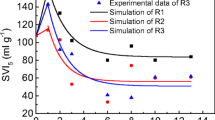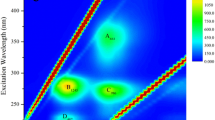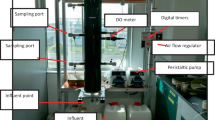Abstract
Aeration intensity is well known as an important factor in the formation of aerobic granules. In this research, two identical lab-scale sequencing batch reactors with aeration intensity of 0.8 (R1) and 0.2 m3/h (R2) were operated to investigate the characteristics and kinetics of matured aerobic granules. Results showed that both aeration intensity conditions induced granulation, but they showed different effects on the characteristics of aerobic granules. Compared with the low aeration intensity (R2), the aerobic granules under the higher aeration intensity (R1) had better physical characteristics and settling ability. However, the observed biomass yield (Y obs) in R1 [0.673 kg mixed liquor volatile suspended solids (MLVSS)/kg chemical oxygen demand (COD)] was lower than R2 (0.749 kg MLVSS/kg COD). In addition, the maximum specific COD removal rates (q max) and apparent half rate constant (K) of mature aerobic granular sludge under the two aeration intensities were at a similar level. Therefore, the matured aerobic granule system does not require to be operated in a higher aeration intensity, which will reduce the energy consumption.





Similar content being viewed by others
References
Adav SS, Lee DJ (2008) Extraction of extracellular polymeric substances from aerobic granule with compact interior structure. J Hazard Mater 154:1120–1126
Adav SS, Lee DJ, Lai JY (2007) Effects of aeration intensity on formation of phenol-fed aerobic granules and extracellular polymeric substances. Appl Microbiol Biotechnol 77:175–182
Adav SS, Lee DJ, Tay JH (2008) Extracellular polymeric substances and structural stability of aerobic granule. Water Res 42:1644–1650
APHA-AWWA-WEF (2005) Standard methods for the examination of water and wastewater, 21st edn. American Public Health Association/American Water Works Association/Water Environment Federation, Washington, DC
Chen Y, Jiang WJ, Liang DT, Tay JH (2007) Structure and stability of aerobic granules cultivated under different shear force in sequencing batch reactors. Appl Microbiol Biotechnol 76:1199–1208
Dubois MK, Gilles A, Hamilton JK, Rebers PA, Smith F (1956) Colorimetrix method for determination of sugars and related substances. Anal Chem 28:350–356
Dulekgurgen E, Yilmaz M, Wilderer PA (2008) Shape and surface topology of anaerobic/aerobic granules influenced by shearing conditions. 4th IWA Specialized Conference on Sequencing Batch Reactor Technology, Rome, Italy, pp. 311–320
Gao DW, Liu L, Liang H, Wu WM (2011a) Comparison of four enhancement strategies for aerobic granulation in sequencing batch reactors. J Hazard Mater 186:320–327
Gao DW, Yuan XJ, Liang H, Wu WM (2011b) Comparison of biological nitrogen removal via nitrite with real-time control using aerobic granular sludge and flocculent activated sludge. Appl Microbiol Biotechnol 89:1645–1652
Horannj E (1986) Purification and characterization of extracellular polysaccharide from activated sludge. Water Res 20:1427–1432
Laguna A, Quattara A, Gonzalez RO (1998) A simple and low cost technique for determining the granulometry of upflow anaerobic sludge blanket reactor sludge. Water Sci Tech 40:1–8
Li Y, Liu Y (2005) Diffusion of substrate and oxygen in aerobic granule. Biochem Eng J 27:45–52
Li Y, Liu Y, Liang S, Feng C (2008) DO diffusion profile in aerobic granule and its microbiological implications. Enzyme Microb Technol 43:349–354
Liu YQ, Tay JH (2007) Influence of cycle time on kinetic behaviors of steady-state aerobic granules in sequencing batch reactors. Enzyme Microb Technol 41:516–522
Liu YQ, Liu Y, Tay JH (2005) Relationship between size and mass transfer resistance in aerobic granules. Lett Appl Microbiol 40:312–315
Liu XW, Sheng GP, Yu HQ (2009) Physicochemical characteristics of microbial granules. Biotechnol Adv 27:1061–1070
Lowry OH, Rosebrough NJ, Farr AL, Randall RJ (1951) Protein measurement with the folin phenol reagent. J Biol Chem 193:265–275
Mosquera-Corrala A, de Kreuk MK, Heijnen JJ, van Loosdrecht MCM (2005) Effects of oxygen concentration on N-removal in an aerobic granular sludge reactor. Water Res 39:2676–2686
Ngian RF, Lin SH, Martin WRB (1997) Effect of mass transfer resistance on the Lineweaver-Burk plots for flocculating microorganisms. Biotechnol Bioeng 19:1773–1784
Shi XY, Yu HQ, Sun YJ, Huang X (2009) Characteristics of aerobic granules rich in autotrophic ammonium-oxidizing bacteria in a sequencing batch reactor. Chem Eng J 147:102–109
Tay JH, Liu QS, Liu Y (2001) The effects of shear force on the formation, structure and metabolism of aerobic granules. Appl Microbiol Biotechnol 57:227–233
Tay JH, Liu QS, Liu Y (2002) Characteristics of aerobic granules grown on glucose and acetate in sequential blanket reactors. Environ Technol 23:931–936
Tay JH, Liu QS, Liu Y (2004) The effect of upflow air velocity on the structure of aerobic granules cultivated in a sequencing batch reactor. Water Sci Technol 49:35–40
Vazquez-Padin JR, Mosquera-Corral A, Campos JL, Mendez R, Carrera J, Perez J (2010) Modelling aerobic granular SBR at variable COD/N ratios including accurate description of total soilds concentration. Biochem Eng J 49:173–184
Wang JF, Wang X, Zhao ZG, Li JW (2008) Organics and nitrogen removal and sludge stability in aerobic granular sludge membrane bioreactor. Appl Microbiol Biotechnol 79:679–685
Zhang LL, Feng XX, Zhu NW, Chen JM (2007) Role of extracellular protein in the formation and stability of aerobic granules. Enzyme Microb Technol 41:551–557
Zheng YM, Yu HQ, Sheng GP (2005) Physical and chemical characteristics of granular activated sludge from a sequencing batch airlift reactor. Process Biochem 40:645–650
Acknowledgments
This research was supported by National Natural Science Foundation of China (no. 21177033), the Research Fund for the Doctoral Program of Higher Education, Ministry of Education of the People’s Republic of China (20092302110059), and the National High Technology Research and Development Program (2011AA060902).
Author information
Authors and Affiliations
Corresponding author
Rights and permissions
About this article
Cite this article
Gao, DW., Liu, L. & Liang, H. Influence of aeration intensity on mature aerobic granules in sequencing batch reactor. Appl Microbiol Biotechnol 97, 4213–4219 (2013). https://doi.org/10.1007/s00253-012-4226-6
Received:
Revised:
Accepted:
Published:
Issue Date:
DOI: https://doi.org/10.1007/s00253-012-4226-6




